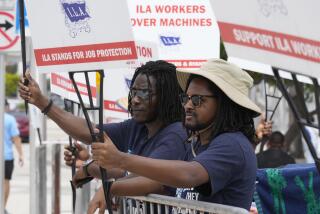Port Complex Is Far From Being Shipshape
Efforts to unclog Southern California’s jammed ports are foundering.
Labor officials said Wednesday that a highly publicized plan to hire and train 3,000 nonunion dockworkers -- touted as a relatively quick way to ease record traffic at the ports of Los Angeles and Long Beach -- has been a disappointment.
As many as one in four of new recruits has dropped out, some in the middle of a shift, according to the dockworkers’ union, which blamed the arduous work and a shortage of equipment to train the new hires.
What’s more, a plan to extend the operating hours of the port’s 13 terminals beginning Nov. 6 has been put on hold at least until early next year, union officials and shippers said.
The upshot: Shiploads of cargo, some destined for store shelves for holiday shoppers, are stranded at sea.
The International Longshore and Warehouse Union and the Pacific Maritime Assn. both cited the lack of workers as a reason for the extended-hours postponement. But each said the other side was at fault. The union and the PMA, which represents West Coast shipping lines, have maintained a delicate detente since a crippling labor dispute in late 2002.
ILWU President James Spinosa called on the shipping lines to promote 1,000 nonunion workers to full union status to provide more skilled labor.
“We are doing our job,” Spinosa said. “We are committed, but we need others to step up to the plate.”
For its part, the PMA accused the union of trying to take advantage of the situation to pad its membership. The PMA, in a statement, said 1,925 trainees had gone to work and that the union exaggerated the losses. The PMA didn’t say how many trainees had quit. PMA officials were unavailable to elaborate.
“A better solution is for the union to encourage registered longshoremen to take skilled jobs for which they are trained and to accept additional shifts. Despite repeated requests from the PMA to encourage union members to do so, the ILWU has failed to respond,” the PMA said.
The port traffic jam has worsened in recent weeks. On Oct. 11, 94 ships waited to be unloaded and the tally has hovered at 85 or more ever since.
That’s the most since the 2002 lockout by shipping lines at West Coast ports idled dockworkers for 10 days and left 129 ships offshore. Normally, the local ports host between 35 and 50 ships at any given time.
Retailers already locked into their shipping schedules have been left with few palatable alternatives, according to port experts, who noted that the cargo crunch was global.
“Countries have outsourced so much of their production to Asia that it has produced far more demands on trade. It’s only going to get worse,” said Roger MacFarland, chief executive of UTi Worldwide Inc. in Rancho Dominguez. UTi Worldwide coordinates the shipment of goods worldwide from manufacturers to retailers.
Casual clothing and gift seller Big Dog Holdings Inc. has received most of the apparel it needs for the holidays but is concerned about running short on some popular holiday items, such as stuffed animals.
“I have some shipments that are stuck right now,” said Cristina Calvi Auda, director of production operations for the Santa Barbara company.
Auda is more fretful, however, about the long-term effect of the port backlog: “If it continues like this,” she said, “I have reason to be worried because then it’s going to affect the next season -- spring.”
A logjam here means shipping containers that are supposed to be emptied and returned to Asia can’t make the return trip so the next wave of shipments can begin, she said.
“They’re going to need a lot of containers overseas that may not be there,” Auda said. “The impact to the future could be huge.”
Self Esteem Clothing in Montebello, which imports trendy clothes for young women and children, has gotten around the problem by bypassing the local ports, Production Manager Jonathon Namm said, a process that began a couple weeks ago.
“What we’ve done, for the most part, is diverted our freight through Oakland,” Namm said. “I’m sure that sooner or later everybody will catch on to that.”
Peter V. Hall, a professor at the University of Waterloo in Ontario, Canada, who has studied the ports of Long Beach and Baltimore, said the problem had become widespread.
“These trade levels worldwide were simply not expected. There is extensive congestion at Rotterdam [Europe’s largest port] and similar reports from British ports and Asia,” he said.
Diversions from the ports of Long Beach and Los Angeles, which together rank third in the world in containership trade, have doubled in the last month from around 20 to 40. Other ports are finding it hard to accommodate the relatively small number of ship diversions that have already occurred.
“It’s causing a ripple effect here,” said John Castanho, president of ILWU Local 10 in Oakland, the West Coast’s third-largest port, where 14 ships that had been headed to Long Beach or Los Angeles have been diverted since July. The diversions have only increased highway traffic as goods that had been bound for here had to be trucked south from the Bay Area.
On Wednesday, the ILWU proposed the creation of staging areas outside the shipping terminals so that containers could be more quickly moved away from the docks.
*
(BEGIN TEXT OF INFOBOX)
Stacked up
Maximum number of ships waiting to unload at the Los Angeles and Long Beach ports each month
July 68
August 71
September 83
October* 94
*Month to date
The normal number of ships waiting to be unloaded at any given time is 35 to 50.
Source: Marine Exchange of Southern California
More to Read
Sign up for Essential California
The most important California stories and recommendations in your inbox every morning.
You may occasionally receive promotional content from the Los Angeles Times.











